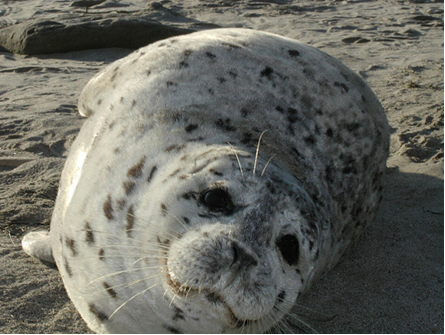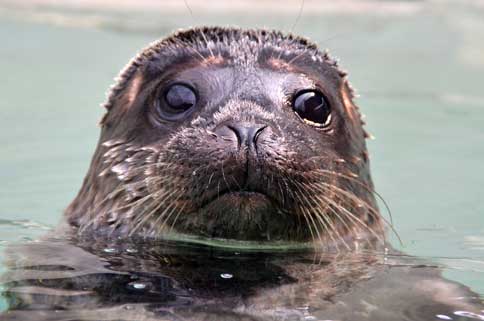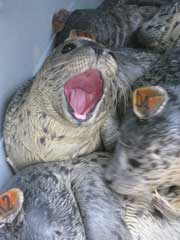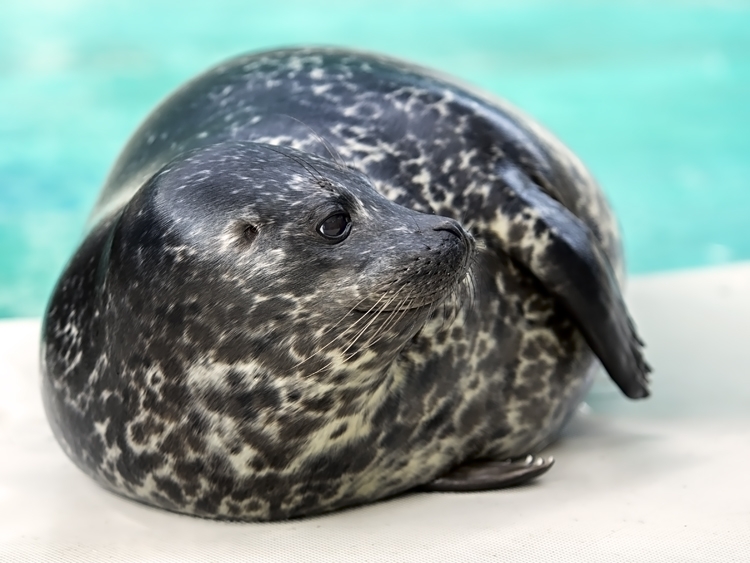Adaptations
Physical Characteristics
and Appearance
Anatomical Structures
Adaptations for An Aquatic
Environment
Sensation
Physical Characteristics and Appearance
In order to identify adaptations of the Phoca vitulina,
we must first understand physical structure and appearance.
Harbor seals have thick, short, coarse hair that sheds every year
after breeding season. This process of “molting” lasts about 1-2
months. The first molt occurs close to birth, and then again after
the pup is one year old (SeaWorld, 2005). Harbor seals lose hair as they age, as with
humans and land mammals alike. Hair is covered by an oil secreted in
the glands of skin and acts as a waterproofing mechanism rather than
insulation. A
layer of thick blubber covering the entire body of a harbor seal
keeps it warm in even the coldest regions of the world (The Brown Reference Group PLC, 2010). Insulation is especially important to seals because of the
high heat capacity of water. A high heat capacity means that it
takes more heat energy away from the seal, dictating the need for
insulation. General
coloration of harbor seals varies from grey, silver, black, or brown
and is often dependent upon environment. Rings and/or spots have
been observed on the back with fewer on the underside. harbor seals
can be characterized into two groups via coloration, the “light
phase” or “dark phase.” Members of the light phase are white,
yellowish, or grey with dark spots. Dark phase seals are brown or black with dark spots and rings (Cale, 2012). In
some areas, such as San Francisco Bay, the iron and selenium
deposits are thought to cause follicle change in the harbor seals’
fur, making the fur a reddish/rust color (SeaWorld, 2005). For more
information on the differing habitats of harbor seals, visit our
Habitat page.

.jpg)
White, grey, and black harbor seal coloration. Photo Credit: Marine
Coloration is affected greatly by habitat. Photo Credit:
Mammal Institute, OSU.
© The Marine Mammal Center
Male harbor seals generally reach adult size at about 4.6-6.6
feet and weigh between 154-375 pounds. Female harbor seals, as with
many species, are smaller in size, but only by a minor size and
weight difference. They grow to be about 3.9-5.6 feet in length and
weigh between 110-331 pounds (SeaWorld, 2005). The male and female sizes and weights do overlap, so it
is essential to understand that although this pattern is consistent,
it is not constant. Rather, it is used as a template to identify
males versus females. Also, these numbers can be generalized to a
number of habitats, with minor differences accounted for. Body shape
is quite similar across several species of seals. The Phoca vitulina
is rounded and “fusiform,” meaning that it tapers off at both ends
to form the head on one end and the hind flippers at the other
(SeaWorld, 2005). Since body shape generally follows the same
pattern for the majority of seals, we rely on differing anatomical
structures to distinguish among species.
Anatomical Structures
Harbor seals share several similar features in body structure as with other land mammals. The first similarity is the general structure of the skeleton. Phoca vitulina possess an endoskeleton, complete with osseous bone and cartilage. Their lumbar vertebrae are stronger and thicker than any other bones which creates stability for the limb bones. These limb bones are shorter than in land mammals, yet very powerful (The Brown Reference Group PLC, 2010). The first set of limb bones are the foreflippers. Foreflippers share the same general skeletal features as a land mammal, with some modifications. Foreflippers have five digits, equal in length. Claws average 1-2 inches in length and are adapted for grooming and defense. Functions of the foreflippers include steering in water, holding prey, and supporting body weight on land (SeaWorld, 2005).
The harbor seal also has a second a set of limb bones in the hind
flippers. Hind flilppers have five bony
digits as in the foreflippers. The only difference is that each digit varies in size, as in a human hand. These digits are
webbed, covered with hair, and have claws. Hind flippers are used to
propel the seal in water because of their higher resistance to water
and act similar to a rudder on a boat. Movement on land does not
utilize hind flippers. Instead, it involves flopping on their
bellies and has often been compared to that of a caterpillar. A
short, flat tail is tucked between the two hind flippers (SeaWorld,
2005).
Moving toward the other end of a harbor seal, we find the head.
Harbor seals have a rounded head with forward facing eyes. The
advantage of forward facing eyes is binocular vision. With binocular
vision, harbor seals can perceive their environment more accurately (SeaWorld, 2005).
Large mouths allow seals to encompass prey, while the 34-36 teeth
are adapted to either tear or crush food depending on the prey (SeaWorld, 2005).
Front teeth are used for gripping and separating food, such as fat
and muscle, while back teeth are used for crushing shells and bones.
Moving outside of the mouth, the upper lip and cheek region are covered
with vibrissae, or whiskers. Attachment to muscles creates a
constant blood and nerve supply, allowing the whiskers to
continually grow. As members of the “true family” of seals harbor
seals lack ear flaps. Instead, they have ear openings that close
when diving (SeaWorld, 2005). Other adaptations for an aquatic environment, including
diving, are discussed in the following section.


Binocular vision is an advantage to harbor seals.
Jaw expansion by young pup.
© Ingrid Overgard - The Marine Mammal Center
Photo Credit: © Adam Ratner -
The Marine Mammal Center

Ear openings on side of harbor seal head.
Photo Credit: Robin
Riggs, © Aquarium of the Pacific.
Adaptations for An Aquatic Environment
Studying the anatomical structures involved in swimming and
diving of the Phoca vitulina help us to better understand how
they have adapted throughout time. Harbor seals swim by using all four flippers. As mentioned
earlier, the hind flippers function as a propeller, while the
foreflippers are used to steer. With these adaptations, seals
can reach speeds up to 12 miles per hour, but typically swim
much slower than this. They are able to swim forward and
upside-down but not backward (The Brown Reference Group PLC, 2010).
When diving, harbor seals utilize these flippers to efficiently
chase prey, escape predators, and play. Harbor seals can dive deeper than 650 feet.
Although seals generally only dive for a few minutes and remain
in shallower waters they are able to dive for longer periods
when necessary. As the harbor seal
dives deeper, seals experience diving asphyxia due to the low
concentration of oxygen. This asphyxia is a combination of
hypoxia (lowered oxygen levels), hypercapnia (increasing carbon
dioxide), and acidosis (an aggregation of hydrogen) (Elsner et
al. 1995). A number of adaptations allow for harbor seals to
continually engage in this diving behavior without serious harm
or death.
Prior to diving, we see the importance of the
first adaptation, the myoglobin of muscle fibers. Myoglobin
binds oxygen tightly and allows muscles to absorb oxygen from
the blood and store it. This storage of oxygen can be accessed
while in low oxygen areas during long dives (Mirceta et al.
2013).
As a harbor seal begins his/her dive, the next few adaptations
become important. Blood is quickly redirected to the areas that
require it most (to the heart, lungs, and brain) (SeaWorld, 2005). Cardiovascular responses such as bradycardia (slowed heart
action) and reduced cardiac output occur. When a harbor seal
begins his/her dive, heart rate lowers immediately.
Vasoconstriction (the constriction of blood vessels) increases
blood pressure and contributes to the theme of oxygen
conservation. Other organ circulation, including the kidneys and
visceral circulation, is either reduced or ceased (Elsner et
al. 1995). Overall, adaptations for efficient use and
conservation of oxygen creates the perfect environment for a
harbor seal dive.
Harbor seal pup returning from a dive.
Photo Credit: Hugh Ryono,
© Aquarium of the Pacific.
Sensation
Whiskers
The most important sense of a harbor seal is touch via whiskers. As mentioned
earlier, harbor seal whiskers are used to “feel” their environment
(Denhardt et al. 1998). Each whisker is part of a hair follicle
with anywhere between 1,000 and 1,600 nerves (The Brown Reference
Group PLC). As the whisker encounters an object or is moved by
water, tiny sensory organs in the follicle recognize pressure
change. These organs send impulses to the brain, which can tell the
seal a variety of information. This information is especially
important when hunting in the dark. Fish leave a “hydrodynamic
trail” when swimming (also known as a wake) which lasts for several
minutes (Denhardt et al. 2001 ). Seals are able to use their
sensitive whiskers to tell the size and velocity of prey and track
the fish, but only over short distances (Lasley, 2011 and Davies,
2011). “They can
measure the height of objects, they can discriminate different
shapes, and they can very accurately determine an object's surface”
(Zimmer, 2001). This adaptation can also be life-saving when
avoiding a predator or finding their way home.
Vibrissae (whiskers) on a harbor seal.
Photo Credit: © Aquarium of the Pacific.
Taste
Taste can also be life-saving to a harbor seal. Harbor seals are able to taste the differences in levels of salt in
seawater. Once a harbor seal is familiar with an area, they begin to
form associations with salt content and types of fish available.
When hunting or migrating, harbor seals can use their sense of taste
to tell location and abundance/type of fish (The Brown Reference
Group PLC, 2010).
Vision
Although harbor seals mainly rely on their other senses, they do have visual capabilites as well. The visual structures of a harbor seal involved in sight actually
change when moving from air to water and vice versa. Throughout
history, harbor seals have evolved sharp eyesight to see through the
transparent air (Zimmer, 2001). In air, harbor seals utilizes two
lenses. The cornea protects the lens from light damage by reflecting
some of it. In water, this adaptation of sharp eyesight does not
benefit the seal. The cornea has a close reflective capacity to
water and becomes unnecessary, so it disappears (The Brown Reference
Group PLC, 2010).
Underwater Hearing
Hearing is not as essential in a harbor seal as touch, taste, and sight are, but it can still help them percieve environmental stimuli. Due to the fact that a seal’s body tissue and the surrounding water
are about the same density, sound waves pass through body tissues
easily. First, they pass through the head and through the less dense
bones of the skull. From there, the waves are conducted to the
middle ear and reaches the inner ears at about the same time (The
Brown Reference Group PLC, 2010).
